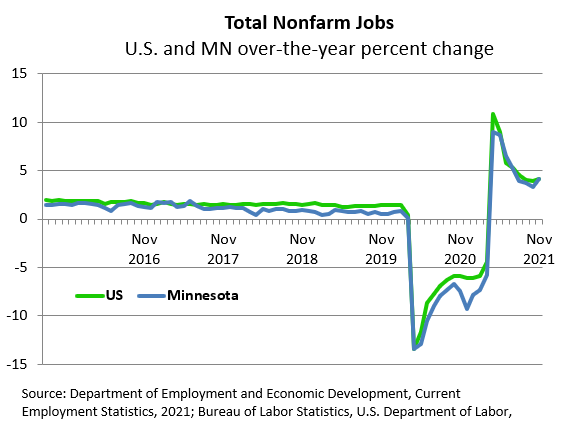By Nick Dobbins
December 2021
The Minneapolis-St. Paul-Bloomington MSA added 1,039 jobs (0.1%) over the month in November. This is roughly in line with the usual monthly change in pre-pandemic Novembers, as employment growth tends to be low. Trade, Transportation, and Utilities drove the most growth, adding 7,557 jobs (2.2%). Retail Trade added 4,842 jobs (3%), as is common as we approach the holiday season. The only other supersector with growth of 1% or more was Other Services, which added 718 jobs or 1%. Declines were greatest in industries that depend on seasonal warmth, led by Mining, Logging, and Construction (down 5% or 4,670 jobs) and Leisure and Hospitality (down 3,758 or 2.3%).
Over the year employment in the metro area was up by 68,883 jobs or 3.7%. It was the largest proportional over-the-year growth of any MSA primarily in Minnesota, tied with Rochester, although it trailed Fargo-Moorhead (5.3%). It was also notably higher than October's 2.8% over-the-year growth, a common trend across regions in the state, in part caused by comparisons with a particularly weak November of 2020. Leisure and Hospitality employers added 30,816 jobs (24.3%), Professional and Business Services added 18,761 (6.1%), and Mining, Logging, and Construction added 6,039 jobs (7.3%). Four supersectors lost jobs on the year, with the largest proportional decline coming in Information, off by 3.8% (1,195 jobs) and the largest real job loss occurring in Financial Activities, which was off by 4,878 jobs (3%), with all of those losses coming in the larger Finance and Insurance component.
The Duluth-Superior MSA lost 70 jobs (0.1%) over the month in November. Mining, Logging, and Construction lost 571 jobs (6.1%), and Leisure and Hospitality lost 268 (1.9%), while Trade, Transportation, and Utilities added 663 jobs (2.8%) with growth in all published component sectors as warm-weather construction and recreation gave way to holiday shopping. Six of 10 published supersectors added jobs on the month.
Over the year the Duluth area added 3,189 jobs or 2.5%. It was the lowest over-the-year job growth of any supersector primarily in Minnesota. Leisure and Hospitality added 2,023 jobs (17.4%), well below the statewide 27.2% annual growth in the supersector, and Manufacturing added 669 jobs (8.7%). Overall growth was tempered by the loss of 483 jobs, or 5.2%, in Mining, Logging, and Construction. It was the largest real and proportional negative growth of any supersector in the area.
Employment in the Rochester MSA was up 0.6% or 747 jobs in November. It was the largest proportional job growth of any MSA primarily in Minnesota although it slightly trailed Fargo-Moorhead's mark of 0.7%. Trade, Transportation, and Utilities employment was up by 904 or 5.3%, led by the addition of 833 jobs (7.1%) in Retail Trade. Government employers added 214 jobs or 1.6%, with all of that growth coming at the Local Government level (up 244 or 2.3%). Manufacturing lost 247 jobs (2.4%), and Mining, Logging, and Construction lost 158 jobs (2.9%).
Over the year, the Rochester area added 4,415 jobs, or 3.7%. This was the largest proportional over-the-year job growth of any MSA primarily in Minnesota, tied with Minneapolis-St. Paul. Leisure and Hospitality employers added 1,645 jobs (18.3%), while the region's Educational and Health Services employers added 1,490 jobs (2.9%). The only supersector in the Rochester area to post negative job growth was Information, which was off by 70 or 5.3%.
The St. Cloud MSA added 320 jobs (0.3%) over the month in November. Growth was driven by the Trade, Transportation, and Utilities supersector, which added 577 jobs (2.6%) with growth in all three component sectors. Six of 10 published supersectors lost jobs, with the largest real and proportional declines coming in Mining, Logging, and Construction, which was off by 362 jobs or 4.4%.
Over the year the St. Cloud area added 2,975 jobs or 2.8%, trailing the statewide mark of 4.1% over-the-year job growth. Growth was tempered by Leisure and Hospitality, which added only 70 jobs (1.1%) in the region despite performing strongly elsewhere in the state. Trade, Transportation, and Utilities employment was up 1,165 jobs (5.4%), Other Services added 223 jobs (6.4%), and Mining, Logging, and Construction was up 568 (7.7%).
The Mankato-North Mankato MSA lost 268 jobs or 0.5% over the month in November. This was the worst mark posted by any MSA primarily in Minnesota. Private sector employers shed 314 jobs (0.7%) while public sector employers added just 46 jobs (0.5%). It was the first monthly job loss for the area since August.
Over the year the Mankato-North Mankato area added 1,554 jobs (2.8%), an improvement over October's 2.4% over-the-year growth. Goods producers added 390 jobs (4%), and service providers added 1,164 jobs (2.5%).
The Fargo-Moorhead MSA added 967 jobs (0.7%) in November, the highest proportional growth of any MSA in Minnesota. Educational and Health Services added 541 jobs (2%), Manufacturing added 291 jobs (2.9%), and Trade, Transportation, and Utilities added 523 (1.7%). Leisure and Hospitality employers lost 139 jobs (1%), and Mining, Logging, and Construction lost 189 (1.8%).
Over the year the Fargo-Moorhead MSA added 7,497 jobs or 5.3%. This was the best proportional growth mark of any MSA in the state. Leisure and Hospitality added 2,466 jobs (20.9%), the largest real and proportional growth of any supersector. The only supersector to lose jobs was Information (down 39 or 1.3%).
The Grand Forks-East Grand Forks MSA lost 206 jobs (0.4%) over the month in November. Mining, Logging, and Construction had the largest proportional decline, off 6.7% (195 jobs) while Leisure and Hospitality had the largest real loss, shedding 317 jobs (5.1%). Trade, Transportation, and Utilities added 297 jobs (2.9%), with Retail Trade adding 235 jobs (3.7%).
Over the year the Grand Forks-East Grand Forks MSA added 609 jobs (1.2%). Leisure and Hospitality added 1,025 jobs (20.8%), and Government employers added 560 (4.3%). Professional and Business Services lost 313 jobs (9.5%).
